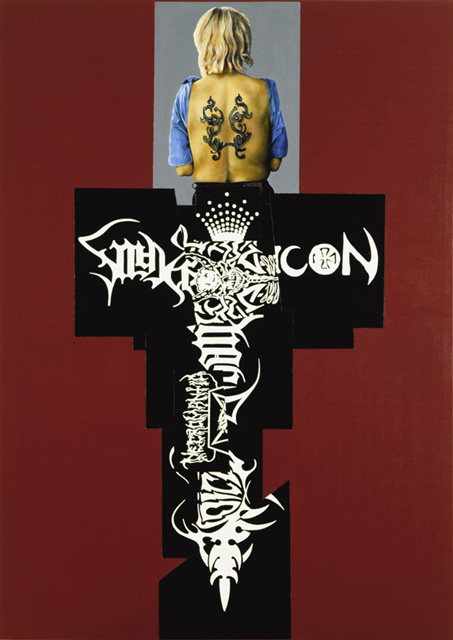


Stieg Persson's paintings reveal his preoccupation with one of the fundamental questions of his generation: Does art any longer have any faith in its ability to be an authentic form of self-expression? To answer the question, Persson has looked inside and outside the fine art tradition. He uses a mix of techniques and styles—abstraction, collage and decoration—all of which have been used by modernist artists of the twentieth-century, in an attempt to break away from the formula of style itself.
Within his own post-modern era, Persson uses abstraction and collage to create a break with traditional representation. He suggests an art in which an artist can only gesture at real meaning, by appropriating images and setting them up in a work of art that demonstrates both a faithless relationship to art and a grieving for its lost potency.
To this end, Persson appeals to a variety of mass culture sources—tattoos, heavy metal graphics, calligraphy, fanzines, X-rays, even stamp decorations. In doing so he challenges the traditional and fiercely defended boundaries between high art and popular culture. Although he might be signalling the redundancy of established art forms by abandoning them for new alternatives, Persson can only increase the power of high art as he increases its repertoire of images by annexing the iconography of popular culture.
The art world was not spared from pre-millennial angst and during the 1990s many theorists, artists and writers announced the end and the death of many of art's founding principals (such as authorship, originality and painting). Persson's use of calligraphy might appear to be a gesture towards clear textual meanings, but they are so elaborately overblown that they obscure any legibility and instead signal the inability of painting to signify anything but its own redundancy. Persson's liberal use of black pigment also suggests that the future of painting in contemporary art was annihilation and meaninglessness. The cross-composition of several of his works, including Painting 1993—Northern Gem (1993), also invoke a sacrifice or loss.
Persson's preoccupation with Scandinavian death metal—a particularly morbid version of heavy rock music—was motivated by his attraction to its nostalgic return to violent and primal Nordic mythology. By appropriating its imagery, Persson brings connotations of annihilation, Armageddon and chaos to the contemporary issue of painting's demise. Interestingly, both death metal and post-modernism have been described as responses to the failure of a utopian project. Death metal marked the failure of the Youth Revolution. Post-modernism replied to the modernist utopia that never eventuated.1
Although he may have been practicing art through the 'death of painting', Persson was also accessing traditional values similar to the Romantic high art tradition of passion, death, violence and transgression. If anything, this suggests that art was in fact completely capable of representing a full-blown, Romantic, melancholic drama, even if this was the staging of its own death.
- Lara Travis
Stieg Persson is represented in Australia by Anna Schwartz Gallery, Melbourne and Sydney.